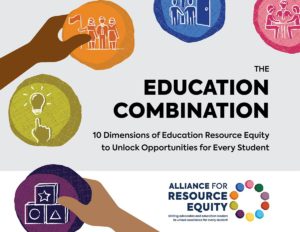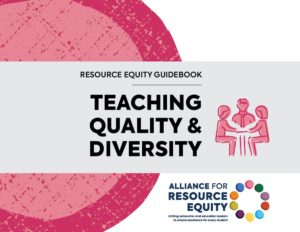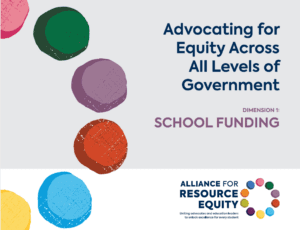The Vision
Each student—including students with higher needs and students of color—has access to high-quality preschool programs that meet their needs, so all students can reach high standards and thrive
Sample Questions to Ask
- What are the rates of pre-K enrollment and attendance in our district?
- What are the evaluation scores for pre-K programs in our district, based on standards such as those from the National Association for the Education of Young Children or the National Institute for Early Education Research?
- How do the rates of pre-K enrollment and attendance in highly rated pre-K programs vary across student groups in our district?
See our DIY District Diagnostic for more examples and recommendations about the types of data to look at.
Take Action With Our Diagnostic Tools
- Use our Resource Equity Diagnostic: Self-Assessment tool to start conversations and build shared understanding across teams.
- Then, analyze your data to better understand the state of resource equity in your district. First, use our Diagnostic Blueprints to learn about what types of analyses to conduct. Then, input your district data into our DIY Analysis Tools to complete these analyses and make meaning of the results.
- Prioritize areas for further inquiry and identify potential root causes and actions using our District Guidebook.
Common Causes of Inequity
- Insufficient Funding: When overall funding levels are insufficient, inflexible, or not transparent, it can limit a districts’ capacity to provide enough preschool programs for students and families.
- Inaccessible Programs: Due to inaccessible application processes, inconvenient locations, or insufficient hours, districts may struggle to provide high-quality preschool to all families of 3- and 4-year-olds.
- Lack of Empowering, Rigorous Content: When the content students learn in preschool is not coordinate with elementary schools, is not culturally or linguistically relevant, or is not developmentally appropriate, students may not be set up for success in their later educational experiences.
Related Dimensions
No single dimension of education resource equity can unlock every student’s potential—but when dimensions are combined to meet students’ distinct needs, they are a strong foundation for unlocking better, more equitable experiences in school.
While all other dimensions are closely related to early learning, one example to explore might be Teaching Quality and Diversity dimension because preschool programs need high-quality and diverse teachers to meet students’ individual needs.
Toolkit
Use our Resource Equity Toolkit to learn more, start a conversation, and take action in your community.

The Education Combination
Learn about education resource equity by discovering 10 dimensions that unlock better, more equitable experiences in school for all students.

Diagnostic Tools And Supports
Identify strengths and gaps in your school system across all 10 dimensions.

Guidebooks
Explore underlying causes of your school system’s challenges and possible actions to improve students’ experiences in school.

Advocating Across Government
Identify who has the power to address equity gaps in your school system and the school district, state and federal levels.

Casemaking Decks
Develop compelling and coherent messaging to “make the case” for addressing resource inequities in your community.
